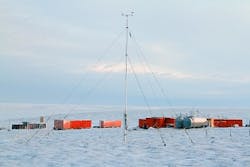Rosneft updates latest Laptev Sea research program
Offshore staff
MOSCOW – The Khatanga-Winter 2017 program, organized by Rosneft with the Arctic and Antarctic Research Institute and Arctic Research Centre, has completed field studies in the southern part of the Laptev Sea offshore northern Russia.
This was the first comprehensive study of the Arctic region at Rosneft’s newest year-round scientific and research base, on the shore of the Khara-Tumus Peninsula in Khatanga Bay.
During the two-month program the scientists studied and determined the morphometric parameters of the ice cover and its dynamic characteristics (speed and direction of ice drift), as well as the physical and mechanical properties of the ice, weather patterns, and water masses.
They assessed the positional relation of ice formations and described the ice cover, setting 40 drifting buoys upon the ice.
Research was conducted at 40 ice bases, using an Mi-8МТВ helicopter and unmanned aerial and underwater vehicles.
Khatanga-Winter 2017 is the third ice-exploration expedition of the company to the Ust-Olenek and Ust-Lensk license areas and the first one to the Khatanga license area.
All the works conducted were carried out taking into account strict requirements for environmental and industrial safety.
Rosneft opened the research base last year, with a view to performing winter research expeditions over its licensed areas in the Laptev Sea, and to serve as a testing ground for new Arctic technologies and materials, in particular ice conditions control technologies.
The base performs year-round monitoring of meteorological, actinometric, hydrological and ice conditions in Khatanga Bay, supported by a weather station.
06/12/2017
